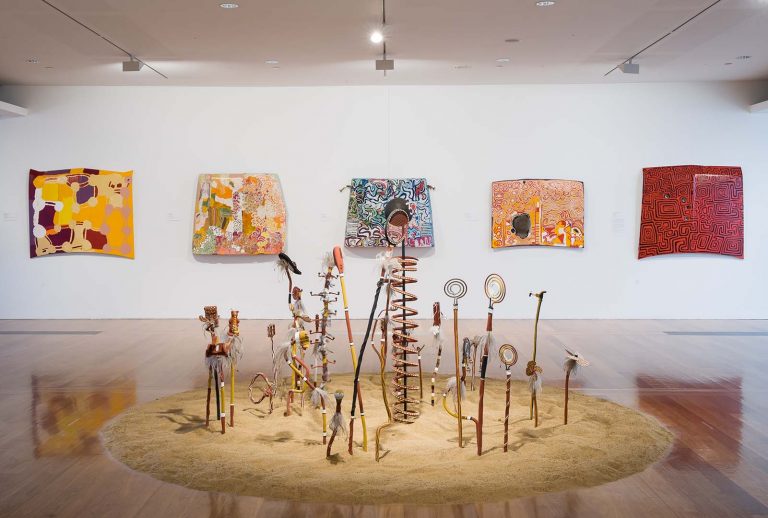We acknowledge the Traditional Owners of the land on which the Queensland Art Gallery | Gallery of Modern Art stands and recognise the creative contribution First Australians make to the art and culture of this country.

Lin Onus / Australia 1948–96 / A stronger spring for David: toas for a modern age 1994 / Synthetic polymer paint on electrical conduit and PVC tubing with wooden bases, a spring, a ball, feathers, string, found objects and sand / Purchased 1996. Queensland Art Gallery Foundation / Collection: Queensland Art Gallery | Gallery of Modern Art / © Lin Onus Estate/Licensed by Viscopy
Lin OnusA stronger spring for David: toas for a modern age 1994
Not Currently on Display
In A stronger spring for David: toas for a modern age 1994 Lin Onus pays homage to David Unaipon, an Aboriginal inventor (active in the early 1900s) and whose contribution to the development of the spring-loaded shear was acknowledged with the appearance of his image on the 1995 fifty dollar bill. Onus said:
It appears that for many years David worked the agricultural shows in rural areas. In a sideshow tent, he had erected a spring upon which a steel ball would fall. The steel ball would bounce back but not quite as high as the point from whence it came. At this point David would explain to the audience his theory of perpetual motion and then pass around the hat, suggesting that if people were to give him some money he could then buy a stronger spring – hence the title of my piece.1
It is surrounded by 34 toas or land markers installed on ten bases which incorporate found objects. Through the construction of toas, Onus also pays homage to the inventiveness and creativity of the traditional Diyari people and associated clans from the Lake Eyre District in South Australia who are attributed with the construction of the enigmatic toas (direction markers) collected around the turn of the century.2
Lin Onus was born in Melbourne in 1948. His father Bill Onus was a Yorta Yorta man from the Aboriginal community of Cummeragunja in Victoria, near the town of Echuca, while his mother Mary McLintock Kelly was from a Scottish family in Glasgow.
As a child, Onus visited Cummeragunja with his father, and was told stories by his uncle Aaron Briggs, who gave Onus his Aboriginal name — Burrinja, meaning ‘star’. After leaving school at 13 he worked as a motor mechanic before joining his father’s business, Aboriginal Enterprises, making artefacts for the tourist market.
Appropriation, copyright and equality associated with the manufacture and trade of Aboriginal tourist items were critical issues that would later occupy Onus’s art and life. The discovery of a set of oil paints at his father’s workshop led Onus to painting small landscapes that he sold through the Sherbrooke Art Society Fair in 1974.
In 1975, Onus mounted his first exhibition at the Victorian Aborigines Advancement League in Melbourne. This organisation was symbolically significant for the young artist, foreshadowing the powerful link between his art and the political and cultural milieu that was to become a distinguishing characteristic of his career.
In 1986 Onus was introduced to the Gamerdi community at Maningrida in Arnhem Land and met traditional elders such as Jack Wunuwun (who became his adoptive father and mentor). Onus’s pilgrimages to the community allowed him to acquire knowledge about symbols, patterns, designs and stories, to develop a distinctive visual language.
In 1993 he was awarded the Order of Australia for service to the arts. Despite his premature death at the age of 47, Lin Onus has been widely acknowledged as a pioneer of the Aboriginal art movement in urban Australia.